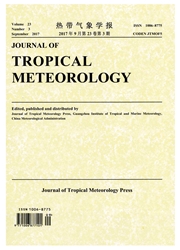

 中文摘要:
中文摘要:
用大气的研究( NCEP/NCAR )和在冬季期间聚集的客观地分析的由空至海的热流动( OAFlux )的环境研究/公民中心的国家中心的每月的分析数据,单个向量分解( SVD )分析被进行揭示在在北方太平洋上在 500 hPa ( Z500 )加热异例和 geopotential 高度的自台湾东面的菲律宾海流向日本的暖流水兵之间的联合模式。第一个 SVD 模式证明当加热异例的北自台湾东面的菲律宾海流向日本的暖流水兵是积极的时,在北方太平洋的中央、西方的节的 Z500 是反常地低的。由填写气象学的领域异例在积极(或否定) 年,这被揭示了当时阿留申群岛之土人低加深(或 shallows ) ,在西北弯屈自台湾东面的菲律宾海流向日本的暖流加强的 overlying (或变弱) 并且导致近表面的空气凉爽(或温暖) 。而且,这增加(或减少) 向上的热流动异例并且冷却(或温暖) 海表面温度(SST ) 因此。在自台湾东面的菲律宾海流向日本的暖流和它的下游的区域的附近,沿着纬度的空气温度的垂直结构是 baroclinic;然而, geopotential 高度是相等地 barotropic,哪个礼品凉爽的马槽(或温暖的山脉) 空间结构。分叉的风和垂直速度被介绍显示出异常带的发行量房间。这些被升起描绘(或下降)在中央诺思太平洋的空气,它向西流动并且向上面的对流层东方,下降(或上升)在自台湾东面的菲律宾海流向日本的暖流并且在北美洲的西方的节,然后加强(或变弱)中间纬度的带的房间( MZC )。
 英文摘要:
英文摘要:
Using monthly reanalysis data of the National Center for Environmental Research/National Center for Atmospheric Research (NCEP/NCAR) and Objectively Analyzed Air-Sea Heat Flux (OAFlux) gathered during the winter, singular vector decomposition (SVD) analysis was conducted to reveal the coupled mode between the Kuroshio marine heating anomaly and the geopotential height at 500 hPa (Z500) over the North Pacific. The first SVD mode showed that when the northern Kuroshio marine heating anomaly was positive, the Z500 in the central and western sections of the North Pacific was anomalously low. By composing the meteorological field anomalies in the positive (or negative) years, it has been revealed that while the Aleutian Low deepens (or shallows), the northwesterly wind overlying the Kuroshio strengthens (or weakens) and induces the near-surface air to be cool (or warm). Furthermore, this increases (or decreases) the upward heat flux anomaly and cools (or warms) the sea surface temperature (SST) accordingly. In the vicinity of Kuroshio and its downstream region, the vertical structure of the air temperature along the latitude is baroclinic; however, the geopotential height is equivalently barotropic, which presents a cool trough (or warm ridge) spatial structure. The divergent wind and vertical velocities are introduced to show the anomalous zonal circulation cell. These are characterized by the rising (or descending) air in the central North Pacific, which flows westward and eastward toward the upper troposphere, descends (or rises) in the Kuroshio and in the western section of North America, and then strengthens (or weakens) the mid-latitude zonal cell (MZC).
 同期刊论文项目
同期刊论文项目
 同项目期刊论文
同项目期刊论文
 期刊信息
期刊信息
